"Coaching Supervision"
by Marco Matera
Apr 26, 2021
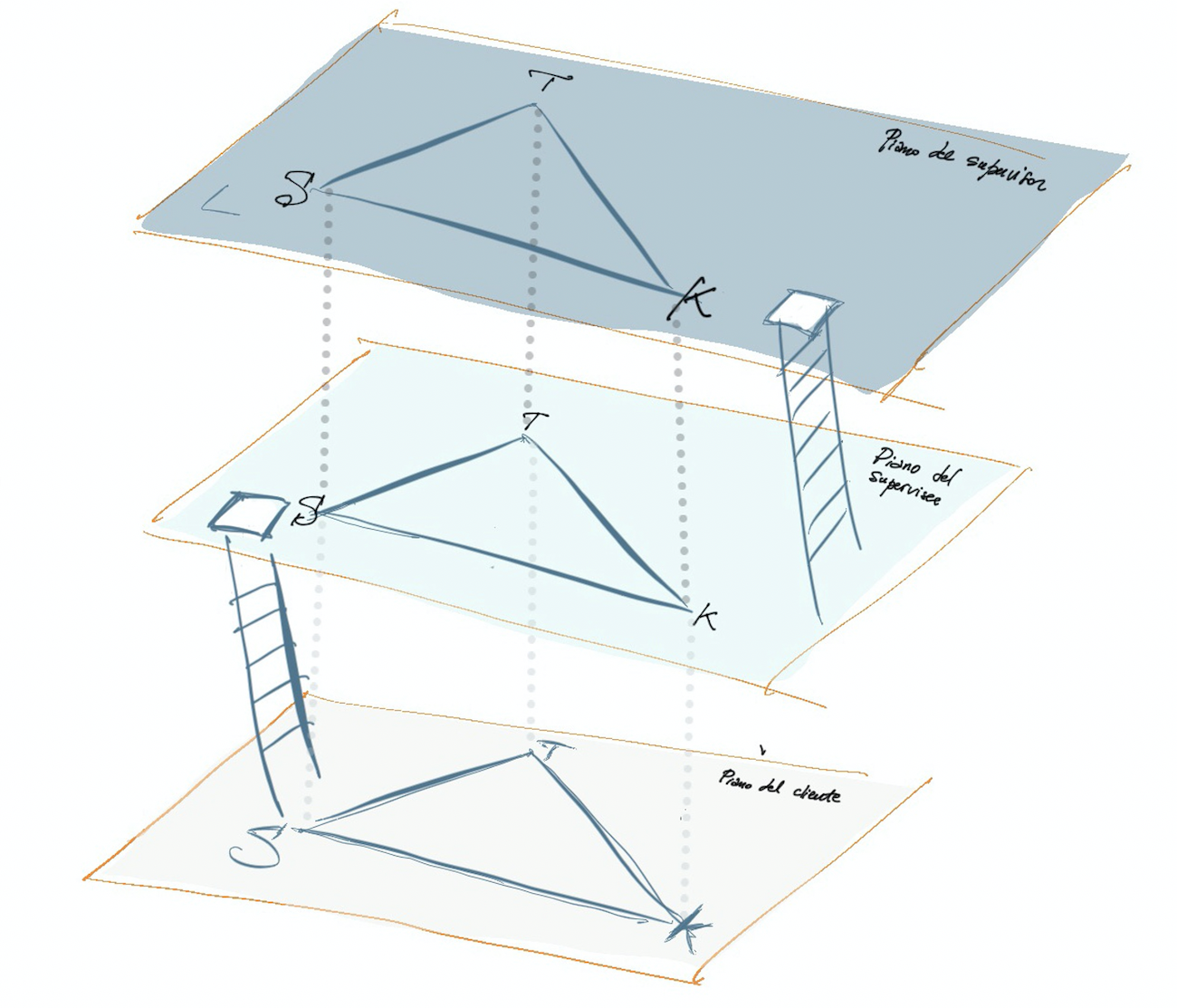
Introduced by Paut-Kromkampt
Marco Matera provides us with interesting insights in the how and why of approaching supervision using systemic constellation ideas.
His clearly illustrated models will help when analysing ones practise and thus has a role in looking in ones own mirror as a supervisor. It also provides guidelines for the considerable skills and knowledge requested of the supervisor, both of the theory and practice of supervision and coaching and of the normative aspects of the field or organisation in which it is applied.
The article touches on the distinction with peer-group supervision models and on how solution focus makes a difference in this approach. Both would make for interesting follow-up reading in my opinion.
The Article
What I want to share is my experience of supervision, offer an overview and present my model so that it can also serve as a support for reflective practice.
I come from the world of counselling where supervision is a “must”; later, as a teacher in a counselling school, I became involved in supervision and developed a systemic-constellation approach to Solution Focus supervision.
Supervision for me is a space where you can stop, analyze your work with the help of external support to see things that you would not see on your own.
I was very impressed by a phrase of Michel Moral[1]:
“it is difficult to make our bed if you stay in it”
I find that this metaphor explains well the richness of the relationship that is created within a supervisory relationship. It allows you to put the folds of your thoughts in order, to have a welcoming place where you can find yourself, a safe space from which to get up and start again with more energy.
I found that being supervised was extremely useful for me, to unblock moments of impasse, to explore more deeply the aspects that made it difficult for me to work with some clients and recognizing some of my own personal dynamics that I had not taken into consideration. Through supervision I was able to improve my ability to be present and to notice more clearly all the systemic interconnections that I had not previously taken into account.
As a supervisor one of my main objectives is to help my client, who is defined as supervisee in the supervision relationship, to increase his degrees of freedom, to increase his scenarios and offer him the possibility to look more deeply at his attitudes, at the intentions that guide his gestures, his approaches, so that he can, in his subsequent sessions, be even more effective, that he can improve even more.
When I started thinking about an article on supervision, my initial reflections were those that you can read in the figure here, in which I identify supervision as a process of critical reflection structured on deontological, methodological, organizational, emotional and relational aspects.
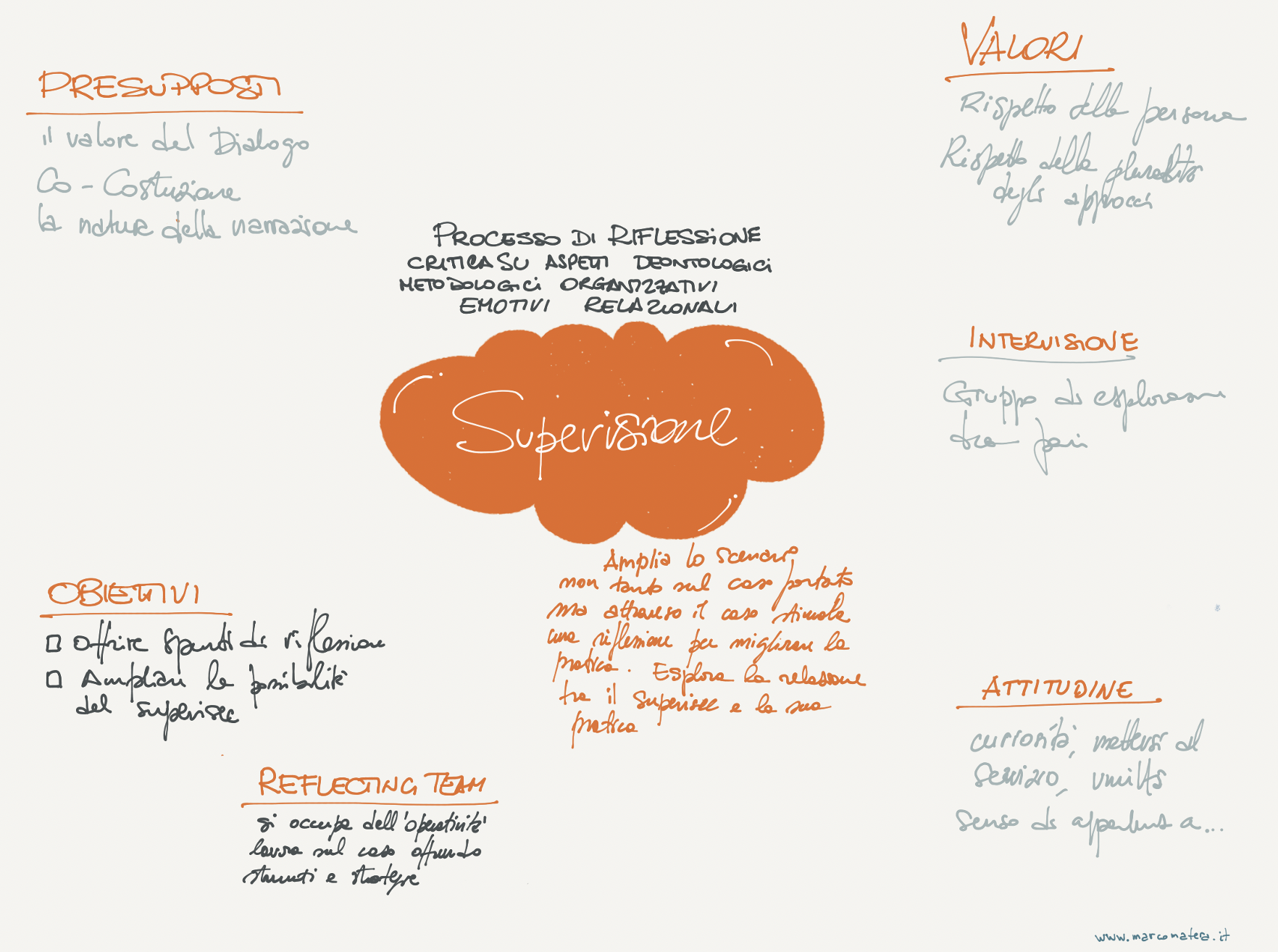
There are many areas in which the role of supervisor is defined, for example, in the film industry, the supervisor plays the role of superintendent: the one who supervises, verifies that things are done as intended.
In coaching, supervision refers to advanced reflective practice with a person trained to do this.
There are terms that may be related to the supervisory activity and may seem similar, but they are different, at least from my point of view: intervision and reflecting team practice.
Intervision means the exchange of peer reflections on a topic brought by a group member. It is not necessarily that the interview follows established canons, theories or supervisory approaches. It offers the advantage of stopping to analyze a topic. It can be compared to the Agile practice of retrospective[2].
With the expression reflecting team we mean a group of peers (therapists, coaches, consultants…) who participate in the session with the client in a more relaxed position and, during the session, share with the coach and/or the client functional aspects of the case; we do not enter directly into the dynamics, unless strictly necessary, between coach and coachee but we focus on the objective of coaching. The advantage is to offer the coach and the client further food for thought.
The supervision in coaching is structured and follows, for the most part, models that were initially developed for therapeutic practice. Counselling supervision models are also derived from the therapeutic models, obviously adapted.
Later authors such as Peter Hawkins, David Clutterbuck[3] and others have developed dedicated models in coaching. Among these we can refer to the “Seven eyed model[4]”, a systemic model developed by Hawkins and Shohet (2012), the models mediated by reflective practice such as Borton’s model (1970), the “Gibbs Reflective Cycle” by Gibbs (1988), the model by Argyris & Schön (1978), the “Supervision of energetic coaching” developed by Florence Lamy & Michel Moral[5]and the models developed by Michael White’s[6] narrative practice.
The functions of coaching supervision were summarized in the scheme proposed by Iskipp and Proctor (1993).
The supervision process aims to help the supervisee:
- in the development of his knowledge, thus responding to training needs;
- in the analysis of ethical aspects and adherence to the code of ethics to which the supervisee adheres, thus responding to regulatory and technical needs;
- in relation to the dimension of attitude, responding to the need for relational support.
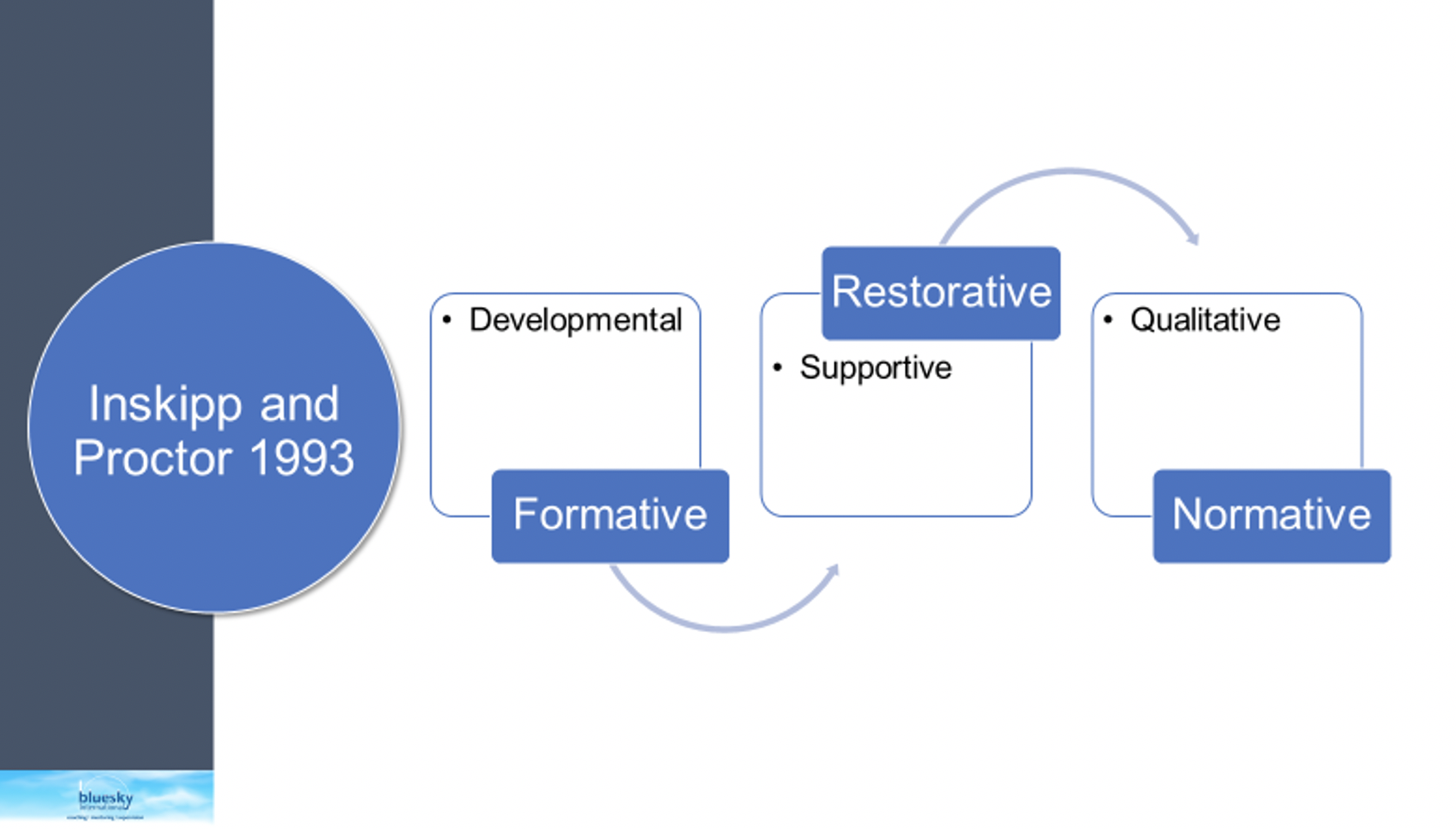
In this article I want to present my reflection arising from a systemic-structural constellation approach that I learned from Matthias Varga Von Kibed[7].
In his “triangle of values” Varga Von Kibed highlights three poles:
- the Pole of Knowledge that concerns knowledge, know-how, data;
- the Pole of Structure that concerns order, rules;
- the Pole of Trust which represents a mix of trust, beauty and passion.
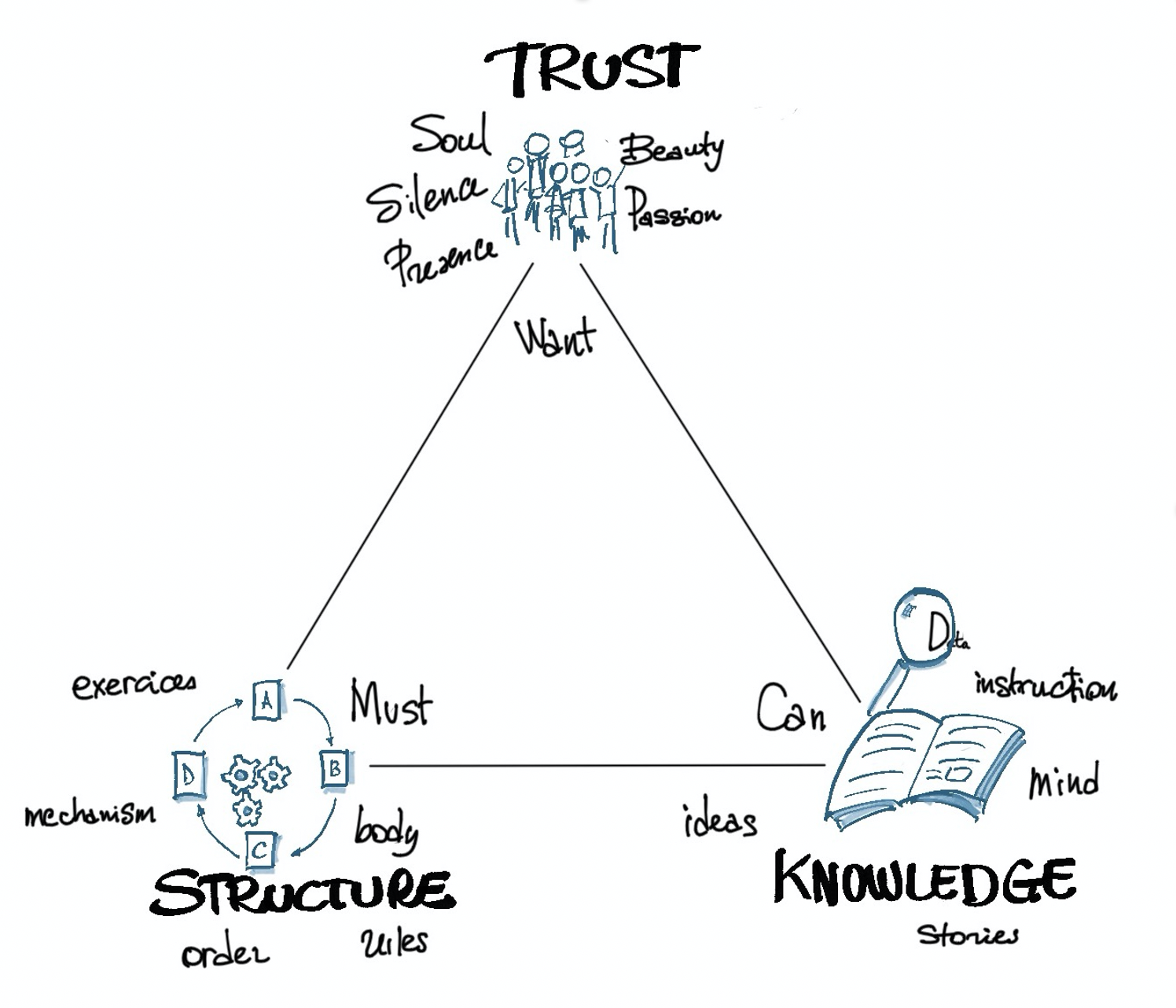
We need to know things, to have data and ideas. We then need to give these contents a sort of structure, to do exercises that allow us to structure knowledge. We need rules and order, we need to be ourselves within a structure. An example of this are the organizational or hierarchical structures of companies. Knowledge and rules are not enough.
We need the relational dimension, the one generated by example, by passion, by the beauty of relationships, by Trust.
I associate the pole of Knowledge with the verb I can because, if I know things, I can act, I can make certain choices. The pole of the Structure, of the Order, of the rules is more tied, in my way view, to the verb I must: I must do things, it is my responsibility and it is often tied to a normative aspect that can be lived as an obligation.
To the pole of Trust at the top, as if it were an element that is higher than the others on a different level, I associate the verb I want: a dimension of motivation.
We can revisit the model of Iskipp and Proctor seeing its overlaps with the triangle of values proposed by Varga von Kibed.
The Knowledge pole is connected with developmental and educational aspects: theories, approaches, objective reality data as well as simple facts.
The pole of Structure is linked to technique, but also to rules, norms. It is concerned both with quality in the sense of adherence to schemes and “normative” aspects. Ethical codes become real working materials for supervisors.
The pole of Trust, of Beauty is related to that part of quality that is more linked to the Art of doing things. It is a deeper dimension that is connected with attitudes, values, beliefs, thus resulting in relational support. It is in this space of Trust that we can open ourselves to the new, to our way of working from a different space.
If we think about the value triangle as a form of language, the pole of knowledge can be represented by words, the pole of structure can be seen as grammar and the pole of trust, of beauty as tone of voice.
What I will describe as a supervision activity, of course, I also apply to myself in my reflective practice, while when I also go into supervision, I allow myself to be guided by the supervisor in me, trusting in the intention that I will discover something new that will allow me to grow.
In my supervision approach, where I integrate the systemic-constellation approach to the solution-focused approach, I explore the dimensions of the triangle.
The dimension of Knowledge, that is, of the data that the supervisee brings, of evidence objective[8], of things that have happened or past experiences, of exceptions, resources is connected with his perception of being able to act or not being able to act because maybe he is a bit “stuck”. In this phase the resources are activated and new possibilities are glimpsed.
The dimension of the Structure is that of the rules, for example the setting, in which his role can emerge, as coach, or how the boundaries have been managed. The dimension of the Structure also concerns the type of structural relationship that has been put into play together with his/her coachee. In the pole of the Structure there are also the dimensions of the Orders and Belongings, for example hierarchical aspects: is the supervisee an internal coach or an external coach? What are the systemic power relations within that coaching relationship? What can the supervisor learn if he or she also looks at those aspects? Have they been considered or not?
If we connect the structure’s core to the “must”, we should also explore all the ethical implications of the various codes of ethics underwritten. I have signed two of them: that of Reico[9] for counselling and that of EMCC[10] for coaching.

The dimension that I prefer is related precisely to the aspect of the relationship, of Trust, of Silence. It is in this space of Silence that we have to deal with presence, with the ability that a coach has to be in that space of non-judgement and receive insights, physical sensations; it is in this space that we can discern how much what we feel is ours or is brought by the client. In this space we can realize our level of presence, our ability to observe ourselves during our session.
We can also view this in terms of Mindfulness: the ability to be in the now, to notice, to be aware of one’s own actions.
The supervision process is centered on the supervisee’s plan but takes into account both his client’s plan and the plan of his role as supervisor.
Each plane has within it the triangle of values and these are superimposed on the various levels. Each plane has the data, the dimensions of the “I can”, the structures and the “must”, the dimensions of trust, the beauty of the relationship, the desires, the dimensions of the will.
If we take the supervisee’s customer plan into account, for example, we can explore objective customer-related data (K) and customer structure (S). Going up to the supervisee’s plan, we can explore the structure of his approach and aspects related to adherence to the code of ethics. Between the client’s plan and the supervisee’s plan their relationship develops and between the supervisee’s plan and the supervisor’s plan the supervision relationship develops.
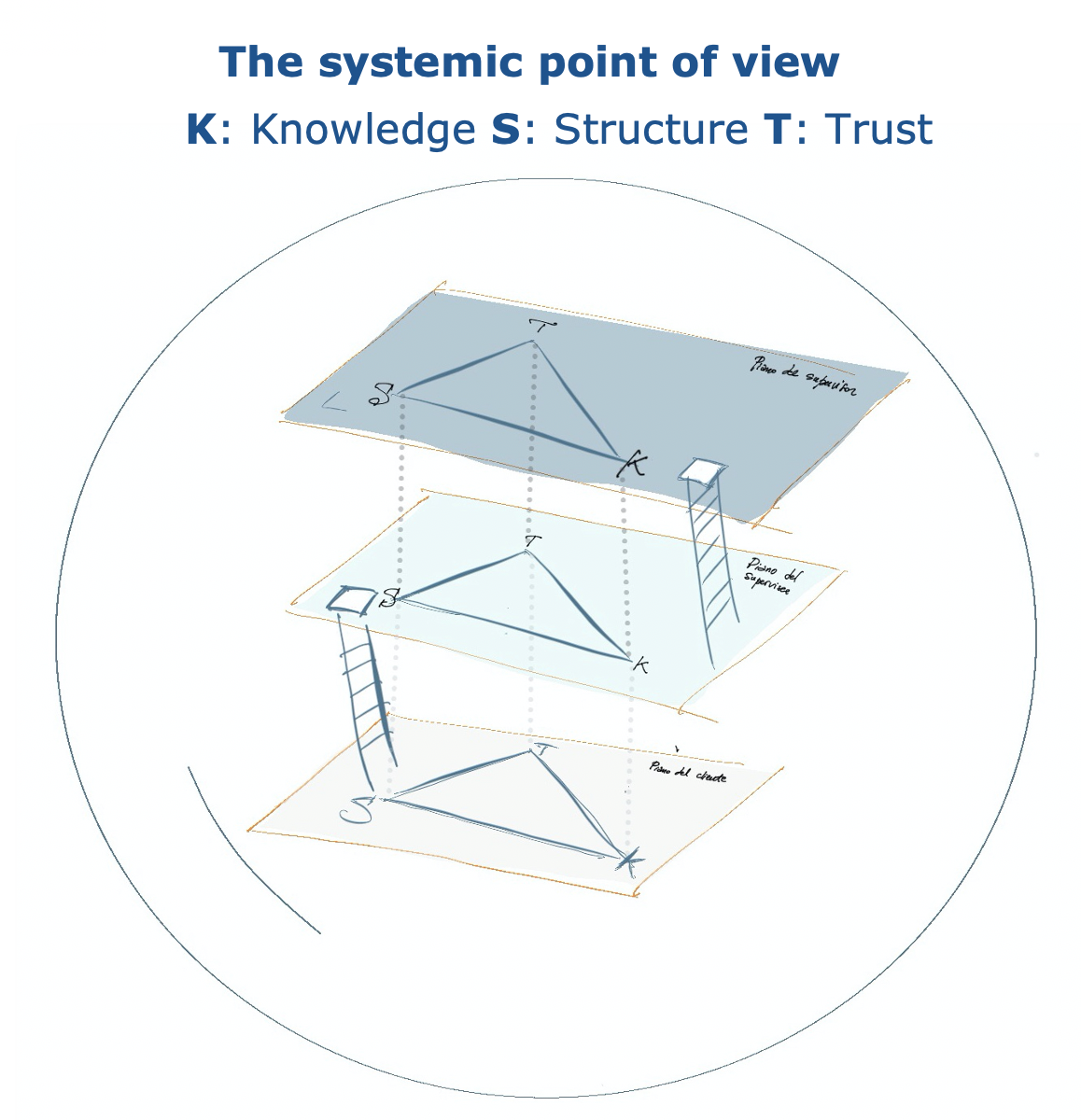
The dotted line connecting the client’s structure with the supervisee’s structure allows us, for example, to explore how their relationship has developed structurally. How has the supervisee’s structure been modified to meet your client’s structure? The same process of exploration can be done on the level of trust or knowledge. In fact, the first level from which we start, in a supervisory relationship, is the dotted line that connects the poles of trust of the supervisee and the supervisor.
Then there is a fourth systemic level that takes into account how these levels interact with the environment, a fourth position that allows you to look at everything from a certain distance.
The role of the supervisor for me is not so much an observer’s role as that of a witness: the observer has a point of reference, observes with a direction, an intention and is focused on that thing because the client has given him a goal. The role of witness is that of the one who is in that moment and observes everything that happens or what he can perceive. This witnessing attitude moves the supervisor to a different level of observation than the observer-coach role.But even a supervisor has his dark corners and that is why he too is required to be supervised.
From a solution focus perspective, which distinguishes me, I see the supervisor as the person who can find the keys to open a mirror door in front of us. The metaphor of the mirror door is the one that represents, for me, the action of reflective practice. The metaphor of the door-mirror is what represents, for me, the action of reflective practice.
The supervisee can stop and look in front of him/herself and in the mirror, in which he/she sees his/her image reflected, he/she can see behind him/herself; he/she can see which are the resources that brought him/her up to that point, he/she can see what happened but always looking ahead, always having as reference not the analysis of the past but the research of new future scenarios. The more we look behind us and the more we stop to see ourselves, becoming aware of our resources, of past successes, the more we will see when we open the door.
With the support of a supervisor we increase the depth of the mirror, we widen the vision because on our own we can only see up to a certain point.
[1] Michel Moral coach, supervisor coach and accredited trainer for EMCC http://www.michel-moral.com http://www.undici.fr
[2] https://searchsoftwarequality.techtarget.com/definition/Agile-retrospective For further information: Peter Hawkins Aisling McMahon “Supervision in the Helping Professions”
[3] David Clutterbuck Carol WhitakerMichelle Lucas “Coaching Supervision: A Practical Guide for Supervisees”
[4] https://www.livingtherapy.co.uk/seven-eyed-model
[5] https://virtual2020.emccconference.org/speakers/florence-lamy-dr-michel-moral/
[6] https://journals.sfu.ca/rpfs/index.php/rpfs/article/viewFile/382/374
[7] https://www.syst.info/de/welcome
[8] things like the number of actors involved, the objective facts, the deadlines
[9] http://www.associazionereico.org
[10] https://www.emccglobal.org
For more information
Edna Murdock, Jackie Arnold; Full Spectrum Supervision; Panoma
Peter Hawkins, Aisling McMahon; Supervision in helping professions